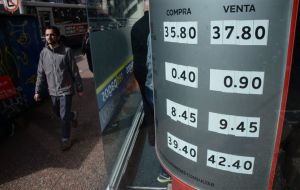MercoPress. South Atlantic News Agency
Uruguay avoids recession, but the economy is stagnant
 Consumption in the private sector remained stagnant (-0.1%) compared to the same quarter last year and the investment was negative again with a 5.8% drop in the year-on-year comparison
Consumption in the private sector remained stagnant (-0.1%) compared to the same quarter last year and the investment was negative again with a 5.8% drop in the year-on-year comparison The Central Bank of Uruguay (BCU) released the report of the country's quarterly economic situation, which reports that the Uruguayan economy grew by only 0.1% year-on-year and 0.3% in the second quarter of the year, compared to the first three months of the year, when it registered a 0.1% drop.
This minimum quarterly growth avoided the technical recession: in the first period of 2019 there was a 0.1% decline in the economy, compared to the last three months of 2018. A recession, technically speaking, is when two consecutive growth falls are registered.
The comparison of the second quarter of 2019 with the same period of 2018 shows a growth of 0.1%. In turn, the first quarter of 2019 compared to the first three months of 2019 had experienced a 0.3% drop.
The BCU report highlighted the positive impact in interannual terms of the transport, storage and communications sector (5.5%), which was offset by a drop in trade, repairs, restaurants and hotels (-2.6%), as well as the manufacturing industry (-1.9%). Construction also closed with a 4.7% drop in the second quarter of 2019 compared to previous year.
On the other hand, consumption in the private sector remained stagnant (-0.1%) compared to the same quarter last year, while government spending expanded 0.4%. Meanwhile, the investment was negative again with a 5.8% drop in the year-on-year comparison in April-June, with a decrease in the public sector of 15.9%, and a moderate fell in the private sector (-1%).
However, by way of compensation, exports expanded 3.5% in the interannual comparison and showed a positive impact of 1 point in the activity of the second quarter. On the other hand, imports dropped 0.3%.
The dollar
On the other hand, in Uruguay, the dollar grew 13.5% against the Uruguayan peso so far in 2019. The US currency closed stable on Wednesday at $ 36.74 in the interbank average, after advancing 0.8% between Monday and Tuesday after the US Federal Reserve reduced interest rates by a quarter of a percentage point. Meanwhile, on the public blackboard of the state bank BROU, the green bill rose two hundredths and was $ 36 for the purchase and $ 37.50 for the sale.





Top Comments
Disclaimer & comment rulesCommenting for this story is now closed.
If you have a Facebook account, become a fan and comment on our Facebook Page!